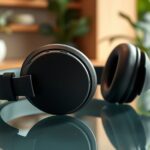When riding with headphones, be sure to use noise-canceling models that allow you to hear important sounds like horns or sirens. Keep the volume moderate to protect your hearing and maintain awareness of your surroundings. Choose secure-fitting headphones to prevent distractions or falls. Regularly lower your volume to stay alert, and consider using features that limit unsafe listening levels. If you want practical tips to stay safe while enjoying audio, keep exploring the options available.
Key Takeaways
- Balance noise cancellation with environmental awareness by using ambient sound modes or keeping volume moderate.
- Choose securely fitting headphones that stay in place during movement without obstructing external sounds.
- Regularly lower volume levels to hear important cues like horns, sirens, and approaching vehicles.
- Use headphones with safety features such as automatic volume limiting or ambient sound awareness.
- Periodically check surroundings by lowering or pausing audio to stay alert and maintain situational awareness.

Listening to music with headphones while riding can enhance your experience, but it also poses safety risks if you’re not cautious. One of the main advantages of using headphones is noise cancellation, which can block out distracting sounds and help you focus on your music or podcasts. However, this feature can also prevent you from hearing important environmental cues, like horns, sirens, or other vehicles approaching from behind or the side. To stay safe, you should be mindful of how much noise cancellation you’re using; opting for a level that still allows you to hear ambient sounds is wise.
Use noise cancellation wisely to stay aware of your surroundings while riding with headphones.
Volume control is another critical aspect to contemplate when riding with headphones. It’s tempting to crank up the volume to drown out city noise or wind, but doing so can be dangerous. High volumes can damage your hearing over time and, more immediately, make it harder to hear external sounds. Keeping your volume at a moderate level ensures you can enjoy your music while remaining alert to your surroundings. Some headphones offer features like automatic volume limiting or alerts when you exceed safe listening levels—taking advantage of these can help you avoid potential hazards.
It’s also worth pondering the design and fit of your headphones. Over-ear or in-ear models can provide better noise cancellation but may also be bulkier or less secure during movement. In-ear buds with good fit can help you stay aware of your environment while still blocking out unwanted noise. Secure-fitting headphones prevent them from falling out during rides, which can be dangerous if you’re trying to adjust or retrieve them while on the move. Always choose a set that offers a balance between comfort, safety, and sound quality.
Additionally, many riders underestimate the importance of regularly checking and adjusting volume levels. It’s easy to set your headphones at a high volume initially and forget about it, but conditions change—traffic gets louder, or you ride into quieter areas. Make a habit of periodically lowering the volume and testing your awareness. If you find yourself constantly turning up the volume to hear your music, it might be time to reconsider your listening habits or invest in headphones with better noise cancellation capabilities. Moreover, advances in AI-driven solutions are beginning to offer new ways to monitor and optimize safe listening levels automatically.
Frequently Asked Questions
Are Bone Conduction Headphones Safer for Riding?
Bone conduction headphones are safer for riding because they enhance your awareness by letting you hear ambient sounds, reducing the risk of accidents. Their equipment durability means they withstand sweat and weather better, making them reliable during rides. You stay connected to your surroundings without sacrificing sound quality or safety. Using these headphones helps you stay alert, making your ride safer while enjoying your favorite tunes or podcasts.
How Loud Should Headphone Volume Be While Riding?
You should keep your headphone volume at a level where you can still hear your surroundings—think of it as a secret to hearing health, not a loud concert. Use your volume control wisely; if you’re cranking it up to drown out the world, you’re risking long-term hearing damage. Keep it moderate, alert, and safe, so you can enjoy your ride without missing the sounds that keep you safe.
Can Wireless Headphones Cause Distractions?
Wireless headphones can definitely cause distractions, especially in busy urban environments with lots of noise. You might miss important sounds like horns or sirens, which can be dangerous. To stay safe, practice good headphone etiquette by keeping the volume at a reasonable level and staying alert to your surroundings. Removing one earbud occasionally helps you stay aware of urban noise and guarantees you’re attentive while riding.
Do Noise-Canceling Headphones Improve Safety?
Imagine you’re in a sci-fi movie—noise-canceling headphones can boost safety, right? They improve noise isolation, helping you focus on your ride. However, they might reduce your ambient awareness, making you less aware of surroundings. While they cut out distracting sounds, they could also hide important cues like sirens or horns. Use them cautiously and consider keeping one ear open to stay alert and safe on the road.
Are There Specific Brands Recommended for Safe Riding?
You should look for brand recommendations that prioritize headphone safety features, like transparent or ambient sound modes, which let you stay aware of your surroundings. Brands like AfterShokz, Apple AirPods, and Samsung Galaxy Buds often include these safety features, making them good choices. Always choose headphones with secure fit designs and volume controls to prevent hearing damage. Emphasizing these features ensures you’re safer while riding with headphones.
Conclusion
So, as you cruise through your journey, remember that headphones are like a double-edged sword—enhancing your experience but risking your awareness. Keep the volume low and stay alert, like a lighthouse guiding ships safely to shore. Think of your senses as a symphony; when one instrument is drowned out, the entire melody suffers. Ride smart, stay vigilant, and let your safety be the steady beat that keeps you moving forward, undistracted and in control.















